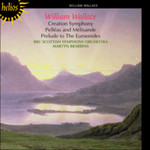|
Back
09/27/2014
William Wallace: Prelude to The Eumenides – Pelléas et Mélisande Suite – Creation Symphony in C-Sharp minor
BBC Scottish Symphony Orchestra, Martyn Brabbins (Conductor)
Recording: Henry Wood Hall, Glasgow, Scotland (June 6-7, 1997) – 73’32
Hyperion Records Helios #CDH55465 – Booklet in English, French and German

   
Typical in the gestation of a composer, William Wallace followed in the footsteps of his father even though graduating in the field of medicine was not his true passion. Wallace’s penchant for philosophy, poetry and even painting consumed his mind, translating into musical compositions which retained a heavier Germanic presence in lieu of Scottish edging. The Greenock, Scotland native was truly a “Renaissance Man.”
After successful release of the first-ever commercial recording of William Wallace’s symphonic poems (Read here), Hyperion takes a daring step to broaden the composer’s exposure by presenting three more pieces which up until this time have been in perpetual suspension. This unparalleled exposure highlights the talents of the evocative Scotsman.
Based on Greek playwright Aeschylus’ final play, The Oresteia, Wallace portrays an ominous leitmotif in the ensuing bars to effect waging war of The Furies which are attempting to decide the fate of Orestes’ horrific homicide. Martyn Brabbins’ erudite reading continues dramatically as the music moderately shifts into the major, representing Athena’s more reasoned approach with re-definition of The Furies as The Eumenides, or “Good-spirited ones.”
Maurice Maeterlinck’s symbolist drama was first interpreted by Wallace ahead of the more prominent Debussy drame lyrique (1902) and Sibelius Suite (1905). Politely coy and soulful (primarily through the bassoon), the opening bars of the “Love” movement reveal subtle Delius shading. In Wallace’s interpretation we hear a more pronounced lyrical discourse when compared to Debussy’s heavier abstract form. The entire vision is owned by Wallace: Brabbins courts a delightfully lush and resonant sound, ending with a beautiful harp glissando. In sheer contrast, we hear a more frivolous side in the “Spinning Song” that opens to a rattling tambourine (i.e. Richard Strauss), interspersed by the strings’ pizzicati to simulate Mélisande’s child-like, carefree innocence.
Making a 180 degree turn, we reach into the conclusion (Wallace composed five movements but only three are retained), “The Death of Mélisande”, with its gravid weight. The selection reminisces back to the first movement with sweeping undulations. It is by far a more resolute display when mapped against Debussy’s score. The closing bars feature horns and gong, adding a distinctly poignant touch, certainly miles apart from the Debussy trailing of strings and distant bells in his closing measures. Two different composers hailing from two different countries, it is a most interesting parallel.
If ever religion played a deep role within a composer’s psyche, then William Wallace would likely be on the top of the list. Devout Christian, his God-inspired work also reflected a larger, more deeply meaningful picture. Balance and insight was key to how this gentleman worked: not abandoning a peripheral, respectful view of alternative religions, he overwhelmed the pages with uncompromised sincerity. A respite of quietude in the initial minutes of the “Adagio – Allegro” ensues, but the softness is suddenly punctured with pops of dotted rhythms by the horns in urgent fashion. The music progresses, becoming more majestic, akin to Wagner’s sweeping strings found in the “Overture” of Die Meistersinger von Nürnberg eventually unraveling into hymn-like approaches. Brabbins’ pious grandeur abounds in the final minutes of the first movement with a crowning royal harp and lilting woodwinds.
Woodwinds continue their advances in the following movement, “Andantino”, with twinkles of effervescence that bring stated modernity (compliments of saxophone) and cinematic value to the piece; celestial lightness pulsates like a super nova, replete with strings and harp.
Mathematics was never far from the mind of William Wallace (a detailed explanation of Wallace’s use of numerology is contained within the liner notes), for the remaining two movements have algebraic formulations: each consists of 293 bars, and symbolic divisions coincide with numerical values embedded within the Biblical matrix. Highly sophisticated and well-thought out, this demonstrates his two-way mind, bringing to light the complexities of lettering structure that Bach and Schumann rendered obliquely. But never mind the calculating values, for the music on a laymen’s surface is intriguing and stunning. The simulation of waves in the final bars of the “Allegro” has a rollicking, Wagnerian rhythmic sequence that doesn’t quit until the section’s termination. Likewise, the ending “Allegro maestoso” has William Wallace folding his doctrinal values inside the musical pages which is Mensa-made. Superficially, the music is splendid, indeed, but delving into the underlying themes is altogether another subject. Brilliant in complexity.
John Purser’s notes are revealing and highly educational for those who want to dig deeper into what William Wallace was all about. Personally speaking, there’s insufficient time to write about all the details of this highly educated and well-articulated academic gentleman. This is a must read/listen CD for those of analytical minds seeking to expand their knowledge beyond the boundaries of traditional classical music. An extraordinary journey.
Christie Grimstad
|